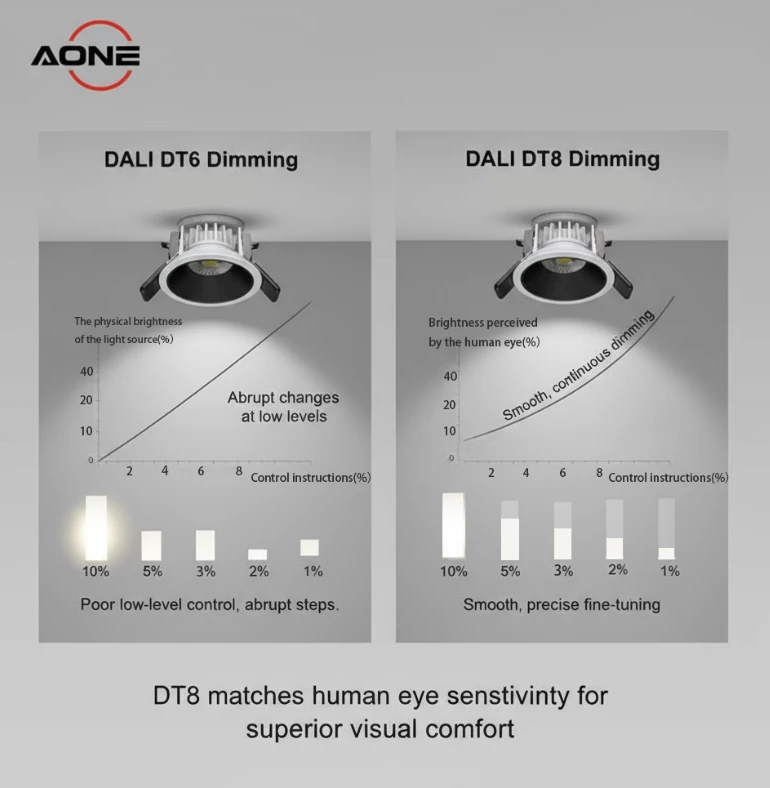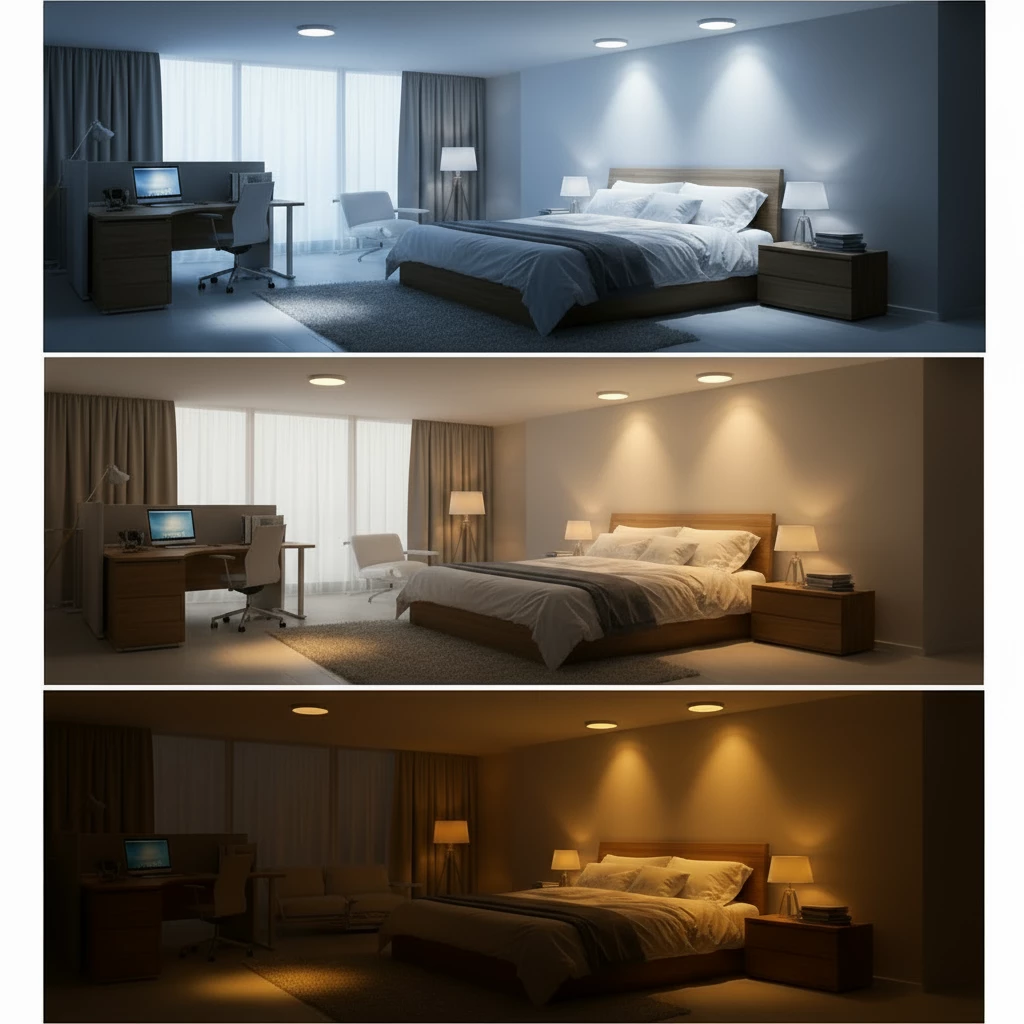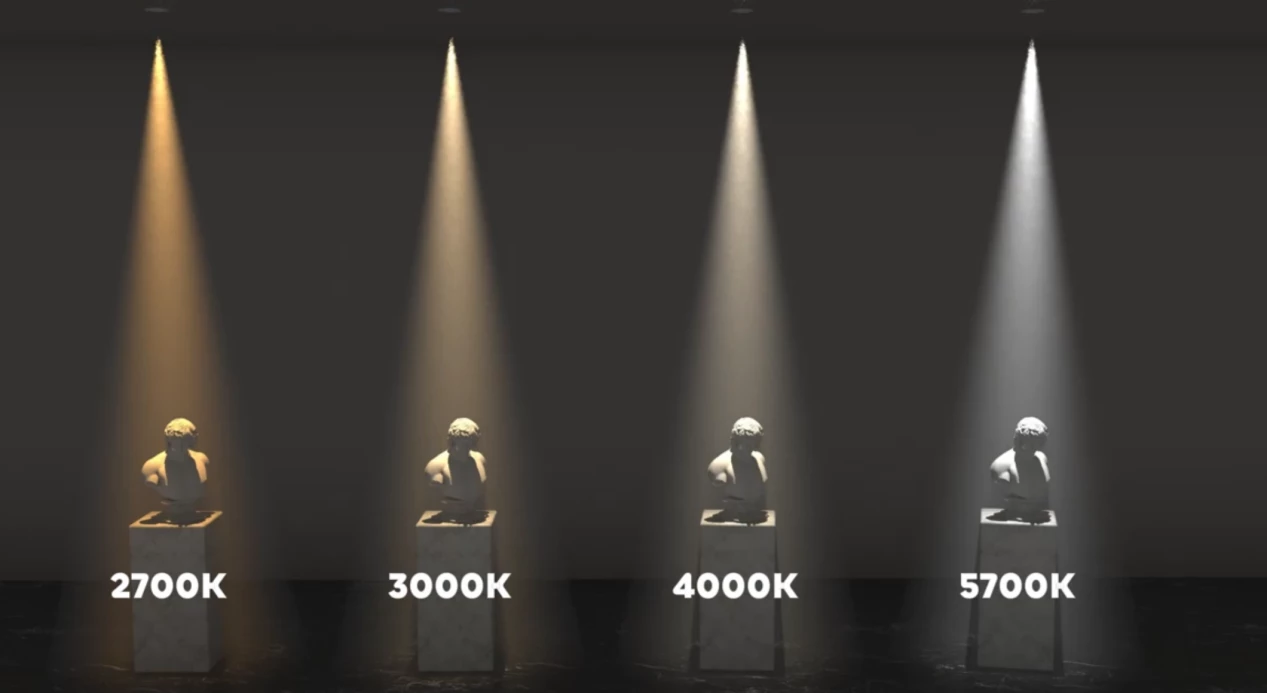Do You Really Understand Dimming and Color Temperature?
 A-ONE
A-ONE
 Sep 09,2025
Sep 09,2025

LED dimming and color temperature control are vital for energy-efficient, human-centric lighting in the EU and Middle East. At A-ONE LED LIGHTING, our advanced LED downlights and fixtures meet stringent EU regulations (e.g., Ecodesign Directive, RoHS) and Middle East standards (e.g., UAE’s ESMA), enhancing comfort and productivity. This guide explores why these technologies matter and how to choose the right system for smart homes and commercial spaces.
Dimming and color temperature transform lighting from passive to intelligent design, reducing energy use and mimicking natural light cycles for well-being. These features are key for EU sustainability goals and Middle East projects, driving searches like "LED dimming EU" and "color temperature control Middle East."
1. Understanding Dimming Through 4 Key Technologies
Dimming technology has profoundly influenced the evolution of lighting, transforming lamps from simple tools into intelligent, human-centric environmental management systems. For markets in the EU and Middle East, where energy efficiency and smart integration are priorities, selecting the right dimming method can lower operational costs and improve system longevity.
Below is a comparison of popular dimming technologies:
|
Feature |
TRIAC Dimming
|
0-10V Dimming |
DALI DT6 |
DALI DT8 |
|
Dimming Type
|
Analog · Phase-Cut |
Analog · Signal |
Digital · Brightness with Color Temperature |
Digital · Full Color and Wattage |
|
Core Function
|
Brightness Only |
Brightness Only |
Dimming + Color Temperature Adjustment |
Dimming + Precise Color Tuning + Wattage Control |
|
System Cost
|
Very Low (Switch Only) |
Low (Controller + Wiring) |
High (Controller + Driver + Programming) |
Very High (Professional Equipment + Design) |
|
Application Scenario
|
Home Retrofit, Low-Cost Projects (e.g., EU Residential Upgrades) |
Garage, Warehouse, Basic Commercial Lighting (e.g., Middle East Warehouses) |
Advanced Offices, Hotel Corridors (Smart Dimming in EU Smart Buildings) |
Museums, High-End Retail, Hospitals (Color Management in Middle East Luxury Spaces) |
1.1 Leading-Edge Phase-Cut Dimming (TRIAC Dimming)
Principle: Uses thyristors (such as SCR or TRIAC) to cut off part of the waveform at the beginning of each AC half-cycle. This method is ideal for retrofitting older systems in EU homes or Middle East villas, where cost-effective upgrades are common.
Features: A mature, low-cost technology commonly found in residential dimmer switches. However, sudden current changes during startup can cause inrush current, leading to noise (buzzing) and electromagnetic interference. For searches like "affordable LED dimming solutions EU," this is a go-to.
1.2 0-10V / 1-10V Analog Dimming
Principle: Uses a separate low-voltage DC signal line (0-10V or 1-10V) to control brightness—higher voltage means higher brightness. This system is flicker-free and compliant with EU energy standards, making it popular in Middle East industrial applications.
Features: Simple, reliable, and flicker-free, with smooth dimming performance. Widely used in commercial and industrial lighting. Requires additional wiring, but it's energy-efficient for large-scale setups like warehouses in Dubai or Berlin offices.
1.3 DALI DT6
Principle: Control commands (e.g., 0-100%) have a strict linear relationship with the physical light output. Doubling the command doubles the light output. Technically, DALI DT6 supports changing the color temperature only, allowing for tunable white adjustments without altering overall power output. This is achieved through standardized DALI protocols (IEC 62386-207), where commands adjust the correlated color temperature (CCT) in Kelvin steps, typically from 2700K to 6500K, ensuring compatibility with EU smart lighting networks.
Features: At low brightness levels (e.g., 1%-10%), changes are abrupt and hard to fine-tune, creating a visual "jump." It prioritizes physical accuracy over visual comfort. Additional technical details include bus-powered communication at 16V DC, with up to 64 devices per line, and fault detection capabilities. Ideal for "DALI DT6 color temperature control" searches in professional EU installations, offering grouping for zoned lighting in offices or hotels.
1.4 DALI DT8
Principle: Control commands correlate linearly with perceived brightness. Complex algorithms (approximating a square-law curve) compensate for the human eye’s sensitivity to low-level light changes. DALI DT8 supports changing both the color temperature and wattage, enabling dynamic power adjustment alongside CCT tuning. Per IEC 62386-209, it handles RGBW or tunable white with power scaling, allowing wattage variations (e.g., from 5W to 50W) while maintaining efficiency. This dual control reduces energy use in Middle East climates by optimizing output based on ambient needs.
Features: Delivers exceptionally smooth and precise dimming across the entire range, especially at low levels (1%-10%), offering a high-quality visual experience. It supports advanced scenes, emergency lighting integration, and up to 64 devices with individual addressing. For SEO, target "DALI DT8 wattage and color temperature" for high-end applications like museums in Abu Dhabi or retail in London.

2. Dimming and Color Temperature: The Perfect Pairing
In modern lighting, dimming and color temperature are intelligently linked. Dual-color-temperature LED dimming is a hallmark of smart lighting systems. Brands like A-ONE LED LIGHTING have refined this technology in downlights, enabling precise and versatile applications tailored to EU energy-saving mandates and Middle East demands.
Principle: Two types of LED chips with different color temperatures (e.g., 2700K-3000K warm white and 5000K-6000K cool white) are installed in one fixture. Their brightness is adjusted independently via separate drivers, allowing seamless blending for custom CCT.
Effect: This technology mimics natural daylight rhythms indoors, promoting circadian health—a key focus in EU wellness standards and Middle East smart homes:
- Daytime: High brightness, high color temperature (e.g., 5700K) simulates noon sunlight, boosting focus and productivity in offices.
- Evening: Brightness and color temperature decrease smoothly to neutral tones (e.g., 3000K-4000K), creating a relaxed transition for hospitality settings.
- Night: Low brightness, low color temperature warm light (e.g., 2700K) reduces blue light exposure, promoting relaxation and sleep, compliant with EU low-blue-light guidelines.

Modern smart downlights like those from A-ONE LED LIGHTING expand these possibilities. such as the Anti-glare Dimmable Front 4CCT Power Changeable Fire Rated Downlight DL191, support multi-step color temperature switching (e.g., 2700K/3000K/4000K or 3000K/4000K/5700K) with 4-CCT presets. This enhances adaptability, making them suitable for homes, hotels, and commercial spaces with flexible and human-centric lighting solutions. Power changeable features (e.g., 6W/8W/10W) integrate with DALI DT8 for wattage control, optimizing for "fire-rated LED downlights EU" and "power adjustable lighting Middle East."

3. Choosing a Color Temperature Control Method
When selecting among DIY control, Tuya wireless, DALI, wall switch switching, or manual dip switches, balance convenience, flexibility, stability, cost, and DIY appeal. For EU and Middle East users, consider local regulations like CE marking or SASO certification.
3.1 For Tech Enthusiasts & DIYers
Recommended: DIY control (e.g., ESPHome)
Why: They seek creative freedom and full control. Solutions like ESPHome allow automation (e.g., time-based color temperature changes) and integration with systems like Home Assistant, perfect for custom setups in tech-savvy EU households.
3.2 For Convenience-Oriented Households
Recommended: Tuya wireless or wall switch switching
Why: Tuya offers smooth color tuning and scene modes at a reasonable cost, app-controlled for Middle East smart villas. Wall switches provide a traditional, reliable option with preset levels—simple and fail-safe for everyday use.
3.3 For Designers or Homeowners Planning a New Build
Recommended: DALI (DT6 for basic color temp, DT8 for advanced wattage and temp control)
Why: With a sufficient budget and a focus on professional-grade stability and precision, DALI is the top choice. It requires planned wiring but delivers unmatched long-term performance, ideal for EU commercial projects or Middle East luxury hotels.
3.4 For Set-and-Forget Users
Recommended: Manual dip switches
Why: If you want to fix the color temperature permanently (e.g., 4000K neutral white for a study), dip switches are the most cost-effective and hassle-free solution. Just confirm settings before installation, great for budget-conscious installations.
Conclusion: Elevate Your Lighting with A-ONE LED
Through this discussion, we see how dimming and color temperature technology transforms modern lighting:
- For individuals: It delivers healthier, more comfortable light that aligns with natural rhythms, reducing eye strain in high-heat Middle East environments.
- For spaces: It uses light to define and shape environments, making it the most adaptable and emotional "soft furnishing" for EU sustainable designs.
- For the industry: It drives the shift from mere "fixture production" to "integrated solutions," becoming a core path to added value.
Ready to upgrade? Explore A-ONE LED LIGHTING's range of dimmable and color-tunable products at www.aoneled.com. Contact us for tailored solutions in the EU and Middle East markets, and boost your space's efficiency today. Search terms like "best LED color temperature downlights EU" lead straight to our innovations

 Home
Home How to Pick Safe and Bright Downlights for Your Home
How to Pick Safe and Bright Downlights for Your Home 


 2F, Building 2, Zhongda Industrial Park, Dongshan Industrial Street, Zhangmutou Town, Dongguan, Guangdong 523619, China
2F, Building 2, Zhongda Industrial Park, Dongshan Industrial Street, Zhangmutou Town, Dongguan, Guangdong 523619, China










